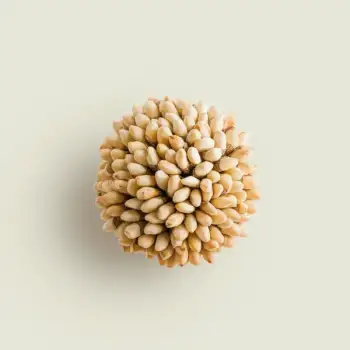Pine nuts and almonds are distinct nuts used in cooking for their unique flavors and textures; pine nuts are buttery and soft, while almonds are sweet and crunchy, enhancing various dishes from pesto to salads and baked goods.

Pine nuts are the edible seeds of pine trees, known for their small, elongated shape and delicate, buttery flavor. They are often used to add a subtle richness to dishes.

Almonds are the seeds of the almond tree, slightly sweet with a firm texture. They are incredibly versatile and used in both savory dishes and desserts.
Pine nuts are soft with a rich, buttery taste and are often more expensive due to their labor-intensive harvesting process. Almonds are crunchier, have a sweet nutty flavor, and are widely available, making them a more cost-effective option.

Your ultimate Recipe Box, Meal Planner, and Cooking Class all in one
Traditional pesto Genovese uses pine nuts to create a smooth, creamy texture and a subtle taste that doesn't overpower the basil. Almonds offer a heartier texture and a nuttier taste to pesto, which can complement robust dishes well.
Pine nuts add a delicate crunch and buttery flavor to salads without overwhelming other ingredients. Sliced or slivered almonds contribute a satisfying crunch and a hint of sweetness to salads, pairing well with hearty greens.
Pine nuts can be sprinkled on top of baked goods like breads and cookies for a mild, nutty flavor and a soft bite. Almonds are often used in baking for their crunch and ability to retain structure, ideal for almond croissants or frangipane fillings.
Both pine nuts and almonds are rich in healthy fats, protein, and fiber, making them nutritious additions to your diet.
| Nutrient | Almonds ( per Ounce ) | Pine Nuts ( per Ounce ) |
|---|---|---|
| Fat | 14g | 19.4g |
| Sodium | 0mg | 1mg |
| Calcium | 76mg | 1mg |
| Protein | 6g | 3.9g |
| Calories | 163 | 191 |
| Carbohydrates | 6.1g | 3.7g |
No, pine nuts are the seeds of pine trees, while almonds are the seeds of almond trees.
Yes, almonds can be used as a substitute for pine nuts in pesto, giving it a different texture and flavor profile.
Pine nuts are more expensive because harvesting them is more labor-intensive, and the trees take longer to produce nuts.
While they can sometimes be interchanged, they will impart different flavors and textures to the dish depending on the recipe.
Both are healthy in moderation, offering good fats, protein, and various nutrients. The choice should depend on dietary preferences and any specific nutritional needs.